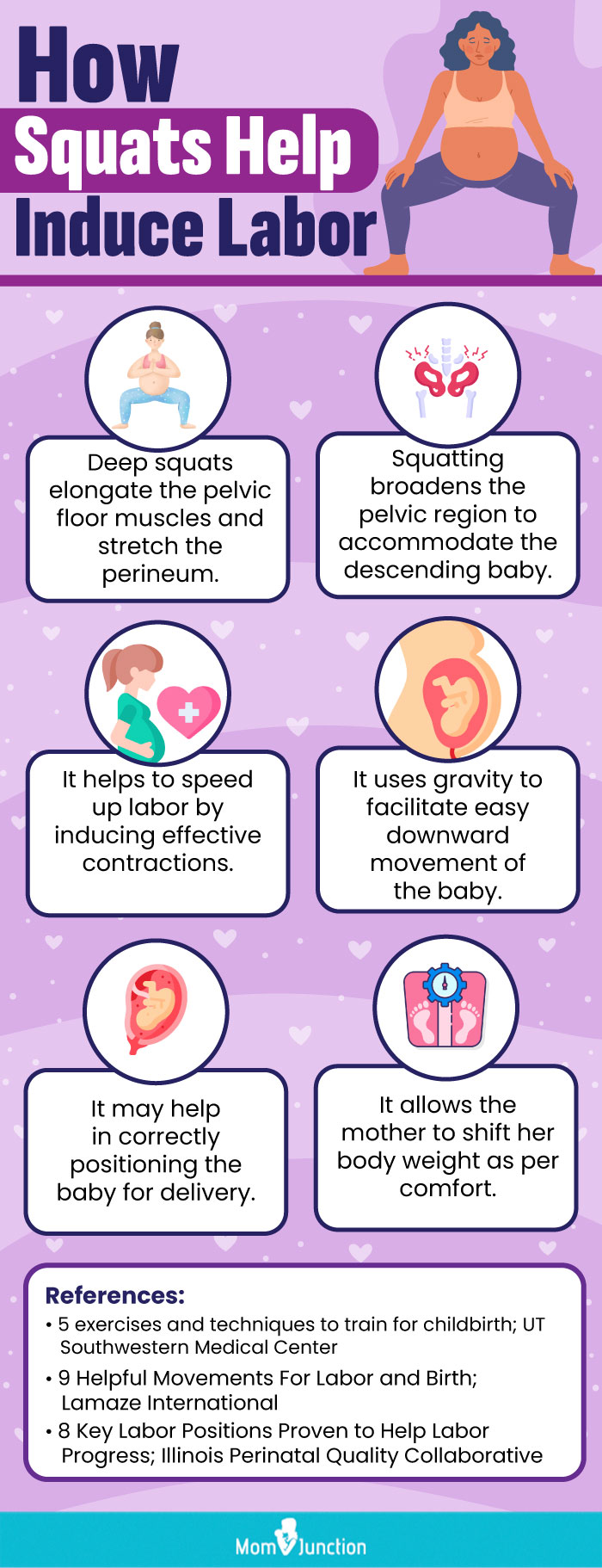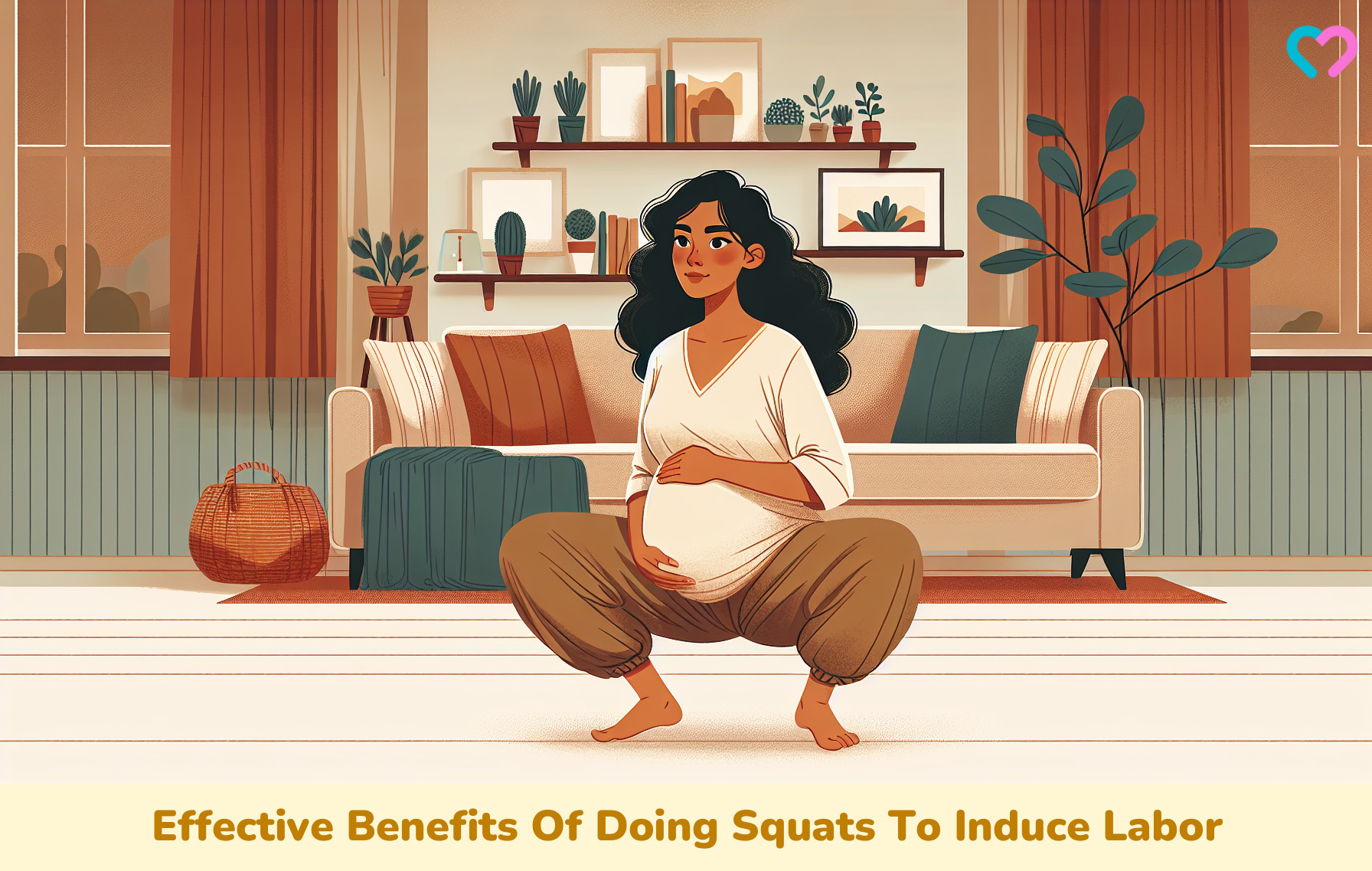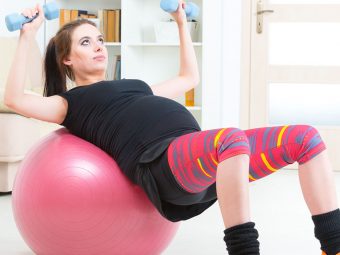
Image: Shutterstock
Among many other physical exercises effective during pregnancy, it is recommended to practice squats to induce labor. Many believe that childbirth is a natural instinct and should not frequently require medical intervention. Our modern lifestyle may have impacted the ways our bodies react, but we can still adopt certain measures that help offer relief to the body.
Pregnancy is a natural phenomenon for which all female bodies are naturally designed, but that does not make it a cakewalk. As pregnancy progresses, the increasing weight of the growing baby bump shifts the body’s center of gravity, making it difficult for a pregnant woman to balance and carry out even simple and regular tasks.
The associated aches, pains, and difficulty sleeping can make things worse, and as the gestation period nears its end, the anxiety of childbirth can overwhelm you. You may seek medical help to induce labor if you are overdue. Always check with your doctor to confirm what’s safe for you. Read on to learn how to do squats to help induce labor and its benefits.
Advantages of Doing Squats To Induce Labor
Image: Shutterstock
Dr. Ariel Sernek, a physical therapist and pelvic health specialist from Woodridge, Illinois, says, “You can use squatting during labor to help maneuver the baby through the birth canal. Squatting with your heels down can help the baby drop into the birth canal at the pelvic inlet. Squatting with your heels up can open the pelvic outlet and improve space for the baby to be delivered.”
Here are some advantages of squatting:
1. The American Pregnancy Association recommends squatting during labor. According to them, squatting can open your pelvic outlet by 10 percent and aid in faster baby delivery.
2. When you squat to induce labor, it creates more room for the baby to move down into the birth canal.
3. Squatting during the third trimester helps strengthen your leg and abdomen muscles. Strong legs and belly are a must when it comes to labor and the final push to give birth.
At the 40-week mark of her pregnancy, fitness enthusiast Andy Sharabi discusses how she uses certain exercises, including squats and brisk walks, to prepare her for childbirth. She says, “I really like doing squats or sumo squats as we get closer to game time cause it helps weights up the muscles that we’d be needing during birth (i).”
4. According to a study conducted by Gardosi And colleagues, squatting, the primitive style, can decrease your labor time by 11 minutes (1)! That’s a long time when you are in active labor.
5. Squatting during pregnancy eases constipation and pressure on the pelvic floor – a blessing during the last few weeks of your pregnancy.
Sometimes labor might be viewed as a pathological process where women need to stay tied to the stirrups. But a number of studies show that free movement during labor can make the process of giving birth shorter and easier (2). With gravity at work, your baby has a better chance of coming out to meet you faster.
 Quick fact
Quick factHow To Squat To Induce Labor?
Image: Shutterstock
Squatting is one of the easiest exercises or forms of physical activity you can try during pregnancy. Here’s a step by step guide to help you:
1. Stand with your feet shoulder length apart.
2. Now lower your whole body till your hip is just a few inches above the floor.
3. Take care of your balance during the final few weeks of the pregnancy. You can take the support of a birthing ball or a kettlebell or can also ask your husband to help!
4. Make sure your heels lie flat on the floor while squatting.
5. Now, rise back again to the original posture.
Repeat as many times as you feel comfortable. Just don’t push your body beyond its limit.
 Quick tip
Quick tipVariations Of Squats You Can Do During Pregnancy
Sumo squats and chair squats may be helpful during pregnancy.
Sumo squats might work on the inner thigh and glute muscles, helping open the thighs. To do them, stand with your feet wide apart, toes pointing outward, and knees in line with toes. Lower yourself into a squat position. Do this for three sets of 10 to 15 repetitions.
Image: Shutterstock
For chair squats, position yourself about a foot away from a stable chair with your feet shoulder-width apart. Slowly sit back in the chair, lightly touching your bottom for one to two seconds. Then, use your glute muscles to stand back up. Perform the same number of repetitions as sumo squats.
Image: Shutterstock
A Word Of Caution
Image: Shutterstock
Though squatting to induce labor is a harmless prenatal exercise in most cases, you must keep some points in mind.
If your baby is in breech position, squatting can prove to be harmful. This is because squatting will force it to descend into the birth canal without giving him or her the chance to move into proper position. So talk to your doctor to make sure your baby is head down before you try squatting during childbirth preparation.
It is also important to discuss other complications regarding fetal and maternal health with your doctor before you take squats to induce labor.
According to Dr. Laura Purdy, a US-based board-certified family medicine physician, “People with certain medical conditions, such as a short cervix, risk of preterm labor, blood pressure, problems, history of miscarriage, may avoid squats or any weight-bearing exercise without their doctor’s permission. However, if you have a normal healthy pregnancy, there’s no reason to avoid squats. That said, be careful because your ligaments will be much more relaxed during pregnancy. So, the risk of you getting injured is much higher.”
Frequently Asked Questions
1. Can squatting break my water?
Squatting in the first and second trimesters is usually not a cause for concern. Squatting in the third trimester, especially in the last couple of months, is not recommended. During this phase, the baby descends into the upper pelvis, and strenuous squats may increase the risk of breaking the water (3).
2. Does squatting help contractions?
Yes. Squatting during labor promotes and intensifies the intensity of contractions, the second phase of labor (4).
3. Does squatting help dilate the cervix?
Yes. The squatting position expands the size of your pelvis during labor progression and uses gravity to promote your baby’s downward movement by applying pressure to the cervix for dilation (5).
The American Pregnancy Association suggests doing squats during pregnancy as it helps relax your pelvic muscles and aids in opening the birth canal. Studies have also shown that squatting before delivery will also reduce labor time. However, make sure you have proper support or take your husband’s help while doing the same. It is advised to consult your doctor about the position of your baby and the safety of performing squats to avoid any unwanted complications during the delivery.
Infographic: Advantages Of Doing Squats To Induce Labor
Squats are a type of exercise that involves lowering your body from a standing position by bending your legs and hips. This movement has been shown to help in inducing and easing the process of labor. Explore the potential advantages of doing squats to induce labor and consult your OB-GYN to try the approach for your childbirth.

Illustration: Momjunction Design Team
Key Pointers
- Squatting during pregnancy can increase the pelvic outlet by 10% and make more space for the baby to move down.
- Squatting strengthens leg and abdomen muscles, crucial for labor and the final push.
- Squatting may reduce labor time by 11 minutes and relieve constipation and pelvic floor pressure.
- The right squatting technique for inducing labor can prevent falls and injuries.
- It’s essential to consult a doctor about the safety of squatting during pregnancy, particularly in the event of complications.

Image: Dall·E/MomJunction Design Team
Personal Experience: Source
MomJunction articles include first-hand experiences to provide you with better insights through real-life narratives. Here are the sources of personal accounts referenced in this article.
i. Due date workout; 40 weeks pregnant.https://youtu.be/RfEe0A8gmeI?feature=shared
References
- Jason Gardosi et al.; (1989); Squatting in the second stage of labour: a randomised controlled trial.
https://www.researchgate.net/publication/20588043_Squatting_in_the_second_stage_of_labour_a_randomised_controlled_trial - Teri Shilling et al.; (2007); Care Practice #2: Freedom of Movement Throughout Labor.
https://www.ncbi.nlm.nih.gov/pmc/articles/PMC1948086/ - Not All Squats Are Created Equal in Labor & Birth.
https://www.lamaze.org/Giving-Birth-with-Confidence/GBWC-Post/not-all-squats-are-created-equal-in-labor-birth - Janesh K Gupta et al.; (2017); Position in the second stage of labour for women without epidural anaesthesia.
https://www.researchgate.net/publication/317188234_Position_in_the_second_stage_of_labour_for_women_without_epidural_anaesthesia - Birthing Positions.
https://www.takingcharge.csh.umn.edu/birthing-positions - Physical activity advice during pregnancy.
https://www.health.gov.au/resources/publications/physical-activity-advice-during-pregnancy - How to Do a Perfect Squat.
https://kripalu.org/resources/how-do-perfect-squat

























